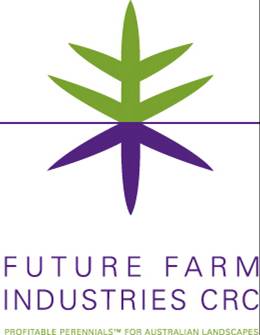Project Activities
The potential benefits to crop-livestock systems as a result of the inclusion of perennial forages include increasing feed availability and potential growth during summer and autumn, increasing the overall farm water use efficiency, making better use of soils with low cropping potential and maintaining groundcover to reduce erosion risk.
Forage shrubs
Through the CRC Future Farm Industries EverCrop has been involved with testing and evaluating the potential for forage shrubs in mixed farming systems. In addition to field sites, this has involved bio-economic evaluation of the profitability and fit for forage shrubs, including new shrub types.
Perennial tropical grasses
Sub-tropical grasses have proven to be capable of persisting and producing forage in the summer-autumn period in the Mallee environment. Current work is exploring the best opportunities for establishment.
The eastern node, covering southern/central west NSW and northern Vic, is a region that already enjoys high levels of adoption of perennial pastures, particularly lucerne. The focus of EverCrop in the eastern region was on pasture establishment to ensure farmers get more out of their perennial pastures. A significant component of work also evaluated a small range of alternative perennial species to lucerne in medium rainfall cropping environments.
Cover-cropping
EverCrop has conducted more than 15 experiments and on-farm evaluations of cover cropping to determine the tradeoffs involved in pasture establishment and in crop yield. Activities included a whole-farm economic analysis of the role of covercrops in a mixed farming enterprise as well as the development of a cover cropping decision support tool.
Spatial arrangement of species in perennial-based mixtures
There is increased interest in improving the productivity, N-fixation and persistence of mixed pasture swards by sowing in alternative spatial arrangements, such as by sowing monocultures of individual species in adjacent rows. This approach may be a very cost-effective way of improving sward composition. EverCrop is evaluating the differences in pasture productivity associated with alternative spatial arrangement as well as determining the impact of different spatial arrangements on subsequent crops.
Spring sowing of perennial pastures
Sowing perennial pastures in spring potentially provides farmers increased flexibility by enabling better weed management, increasing grazing area over winter and reducing the demands during the busy crop sowing window. However, the unavailability of suitable (annual) legume species to complement the perennial species is limiting. EverCrop is exploring the feasibility of sowing perennial-based pastures in spring.
Alternative perennial pasture species
Very few viable alternative perennial pasture species other than lucerne exist in the eastern region, particularly in the medium-low rainfall cropping zones. EverCrop has assessed phalaris and cocksfoot in low-rainfall environments and quantified their potential role in improving groundcover and productivity compared to lucerne. EverCrop continues the assessment of their impact on nitrogen dynamics with a view to presenting them as a viable alternative to lucerne in cropping rotations.
NORTHERN
Activities are focused on valuing the production and environmental impacts of ley pastures in sub-tropical cropping systems, comparing perennial pastures relative to other options over the short & long-term. The benefits are currently known to be varied and often under-estimated.
Ley pastures
On-farm testing of multiple characteristics is quantifying the benefits and costs to provide more comprehensive information on the economics and management considerations of ley pastures in the Northern grain growing regions of southern Queensland and northern NSW.
WESTERN (MEDIUM AND HIGH RAINFALL ZONE)
Pasture cropping
EverCrop will continue to develop a better understanding of the performance of pasture cropping including soil water dynamics, soil biology, nitrogen supply and loss, soil carbon, ground cover and pasture composition. New activities will extend the pasture-cropping approach to more southern WA cropping regions with possible new species mixes. This will include 2 on-farm demonstrations on the WA south coast involving pasture cropping with different perennials such as lucerne and kikuyu in partnership with local groups.
Tedera
Tedera is a perennial legume developed for Australia through the CRC Future Farm Industries. EverCrop is evaluating its potential and fit across a range of Australian regions. To do this it is conducting field trials, developing the capacity to predict growth and evaluating its economic potential across grain growing regions of southern Australia.
OTHER:
From 2012-15 a sister project, EverCrop Carbon Plus, was established as part of the National Soil Carbon Program to investigate the potential to sequester soil carbon in cropping landscapes by incorporating perennial species.
Evaluating Tree and Shrub Placement Trade-offs
An overarching tree-focused activity will focus on optimal placement of trees at a whole farm scale. It will use existing agro-forestry research capacity and models so that tree placement and tradeoffs can be included in whole-farm scenario analysis. The objective is to integrate existing work in agro-forestry with EverCrop’s systems and whole-farm approach. This will present ways that grain growers may best evaluate whether tree plantings are economic, where in the farm landscape and what designs may improve tradeoffs with crop production and environmental benefits (factoring in wind break effects, crop-tree competition; water use; biodiversity and economics).
Farming systems bio-economic analysis and adoption
In addition to regionally-based research and development EverCrop has conducted broader research on the role for perennials across Australian mixed farming regions. This has included:
Analysis of the likely future forms of integration of pastures for greater productivity and adoption across different
regions
Spatial grazing systems
The integration of cropping and grazing objectives remains a major management challenge on mixed farms. As an example, very large paddock sizes are most efficient for cropping but best grazing management and erosion management usually requires small paddock sizes. EverCrop is conducting an analysis of the potential for sub-paddock spatial grazing management (e.g. through sub-paddock temporary fencing or the emerging virtual fencing technology) in a mixed farming system. Using a whole-farm bioeconomic model it will identify the potential profitability and soil management benefits to inform further development of this technology.
Perennial grains
Globally there is increasing interest in the potential for perennial grain crops to offer for new grain production and environmental land use opportunities. As a relatively minor component of EverCrop, the performance of potential perennial grains options in existing field trials is being evaluated and over the coming years results will be included in modelling & economic analysis together with potential end-user consultation.





